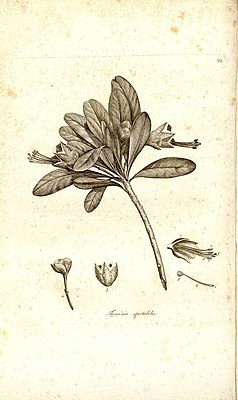Humbertia madagascariensis
| Humbertia madagascariensis | ||||||||||||
|---|---|---|---|---|---|---|---|---|---|---|---|---|

Illustration of Humbertia madagascariensis |
||||||||||||
| Systematics | ||||||||||||
|
||||||||||||
| Scientific name of the subfamily | ||||||||||||
| Humbertioideae | ||||||||||||
| ( Pichon ) Roberty | ||||||||||||
| Scientific name of the genus | ||||||||||||
| Humbertia | ||||||||||||
| Lam. | ||||||||||||
| Scientific name of the species | ||||||||||||
| Humbertia madagascariensis | ||||||||||||
| Lam. |
Humbertia madagascariensis is endemic in the southeastern Madagascar occurring plants art . It is the only species of the genus Humbertia , which in turn the only genus of the subfamily Humbertioideae the family of wind plants is (Convolvulaceae). The species differs in many characteristics from the rest of the bindweed family.
description
Humbertia madagascariensis is a large evergreen tree of up to 30 m in height and over 1 m in diameter, the trunk of which does not develop an internal phloem . The short petiole of the leathery, alternate, firm and simple leaves heaped at the branch ends is 7 to 14 mm long. The obovate, lanceolate and entire, glabrous leaf blade is 30 to 105 mm long and 13 to 40 mm wide, the base is pointed to wedge-shaped. The tip is indented to rounded or pointed. The stipules are missing.
The zygomorphic and yellow, hermaphrodite, five-fold and stalked flowers with a double bloom cover stand individually or in small groups in the leaf axils. The slightly unequal, almost free sepals have five vascular bundles; the calyx does not enlarge on the fruit. The overgrown, folded and externally hairy crown with short lobes is cup-shaped. The stamens are protruding, their bare stamens at the base of the crown are bent in the bud , the anthers are brownish. The pollen grains are smooth. The bald pen is protruding. The small, heady scar is cup-shaped. The hairy, two-chambered ovary is above. About 20 ovules are formed. There is a disc under the ovary.
The first yellow, then red and, when ripe, dark brown and egg-shaped, small fruits are wrinkled, about 1.5 cm long, smooth and slightly leathery berries or non-opening capsule fruits with a persistent calyx that contain one to four seeds .
Systematics
As a sister clade, Humbertia madagascariensis is opposite to the rest of the convolvulaceae. Taxonomically, the species is classified by the remaining bindweed family by classifying it in a monotypical subfamily Humbertioideae or in a monotypical tribe Humbertieae.
Botanical history
The species was first described in 1786 by Jean-Baptiste de Lamarck . The first systematic classification in the vicinity of today's Solanales dates back to 1891, when Baillon assigned the species to the nightshade family (Solanaceae) due to the high number of ovules . Two years later Hallier incorporated the species into the tribe Erycibeae within the bindweed family, which later authors also adopted. Marcel Pichon, on the other hand, established the monotypical Humbertiaceae family in 1947. Molecular biological studies showed, however, that a tribe Erycibeae containing this species would not be monophyletic, but that the species is so close to the rest of the bindweed that its inclusion in the family is justified.
use
The very heavy and very hard as well as very durable wood , ironwood is used for various applications. However, little is used because it is extremely difficult to saw and machine.
literature
- Saša Stefanović, Daniel Austin and Richard Olmstead: Classification of Convolvulaceae: A Phylogenetic Approach . (PDF), In: Systematic Botany. Volume 28, Number 4, 2003, pp. 791-806.
- Th. Deroin: Famille 171 .-- Convolvulaceae . In: Ph. Morat (ed.): Flora de Madagascar et des Comores. Muséum National D'Histoire Naturelle, Paris, 2001, ISBN 2-85654-212-3 , pp. 11-22.
- G. Rakotovao, AR Rabevohitra u. a .: Atlas des bois de Madagascar. Éditions Quæ, 2012, ISBN 978-2-7592-1871-4 , p. 75 f, limited preview in the Google book search.
Web links
- Humbertia madagascariensis at PROTA.
- Humbertia madagascariensis near Agroneo.